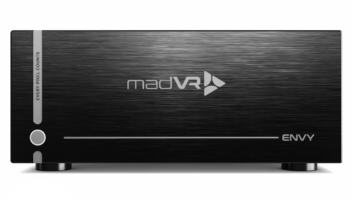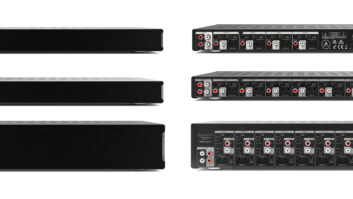Lets face it, cables arent pretty. Out of sight, out of mind has rarely been more apt. Hidden wires and cables is one of the main reasons why distributed audio gets to be called nicer adjectives, like sexy, desirable, and simply, fantastic. One company that has been a mainstay in that arena is Australia-based LeisureTech Electronics, whose A-BUS technology has been on the market for nearly 10 years and continues to find a loyal following even as more flamboyant systems threaten to overshadow its achievements.
Even though A-BUS eventually gained firm footing in the market, the concept behind the technology was not initially an easy sell to jaded integrators and manufacturers. The biggest hurdle has been overcoming peoples old habits, said Andrew Goldfinch, co-inventor of A-BUS and LeisureTechs founder. Change is upsetting to a lot of folks, and they are hesitant to try something new.
LeisureTech had long sought a way to eliminate the long speaker runs and the subsequent power output and sound quality issues that were the bane of most distributed audio systems up until the mid-1990s. At that time, LeisureTech seized on the cabling opportunities afforded by the new cable Cat-5 standard and created A-BUS as a one-wire solution that side-stepped sound and output problems by placing the amplifier behind the wall-mounted room keypad.
As clever yet simple as A-BUS was, industry reluctance to recognize it as a viable multi-room distributed audio solution hampered its efforts to crack the U.S. market, initially. It was an option then to jump on board and take the product to market, said Channel Visions Darrel Hauk, who turned A-BUS down in its early years. It was an opportunity, but we decided to stay with the traditional speaker wire, matrix-type product. I didnt have the vision then. Oscar Ciornei [former CEO of Russound] really saw how A-BUS could be taken to market with the structured wiring industry.
In 2000, Russound became A-BUS first licensee in the U.S. Currently the company has several licensees in the U.S., including Channel Vision, Eaton, Phase Technology, Jamo, Suttle, Cambridge Audio, Honeywell, USTec, DSC, MTX, Harman Kardon, and Onkyo Integra.
I was one of the first to deal A-BUS in New Jersey, recalled Nick Tamburri of Aggressive Home Automation Design, an A/V design and installation firm. I worked closely with Russound because they were one of the first ones to market it; it was very sexy looking. If you showed somebody a regular volume control and then you showed them the control for A-BUS and what it can do, and understand what the product can do, then they were sold.
A-BUS works by distributing four different kinds of electronic information throughout the house simultaneously via one Cat-5 cable: a full-frequency audio signal, systems power for the amplifier, infra-red data for remote control, and system status information for the end user. One Cat-5 cable, which can run up to 300 feet, goes to each rooms keypad from the main system site or hub, which can be located either with the source components or in a structured wiring panel. In either case, if an A-BUS-ready amplifier is used, then a RJ-45 patch lead is all that is needed to connect to the A-BUS system.
The difficult road to recognition and respect might have been a blessing in disguise for LeisureTech. In a time when new technologies are announced with great fanfare only to fall to the wayside or languish in the middle ground occupied by several similar products, the A-BUS platform has managed to plant one foot in the custom installation market and the other in the builders segment, where its incorporation in the structured wiring phase of new builds has raised its profile.
We chose to become an A-BUS licensee because we firmly believe in the technology and its simplistic requirements for installation, said David Richards of electrical systems manufacturer, Eaton Electrical. All the system needs for installation is Cat-5 wiring and a few components. Our main customer is the electrician. We needed an audio product line that was simple to install yet robust in its offering. A-BUS gives us that product line.
Other manufacturers and dealers have matched Richards enthusiasm for the platform, universally noting the systems affordability, upgradeability, and easy integration as huge plus points. The advantage of it [is] that you could match the price of regular install for volume control but give them so much more flexibility, Tamburri said. The way I do structured wiring, I always leave some extra Cat-5 wound up somewhere so you can upgrade later on if they wanted to add anything. For a four-zone A-BUS, which is about $500-$600 for kit [along] with entry-level speakers, you can give somebody four zones of audio or eight zones of audio for a decent price.
Steve Schindehette, an installer and dealer with Auditory Sensations in Orlando, Florida, is similarly pleased, noting that A-BUS is appropriate for a broad range of clients, but mostly first-time home buyers whose budgets usually cap out at $5,000 when considering a whole-house audio system. A-BUS is a very reliable product with enough open architecture to exceed expectations for first-time audio buyers, Schindehette continued. It does help me expand homes past the standard six-zone systems, which is nice.
But praise is no good without healthy criticism. A-BUS, by no means a little chugging system, does have limitations particularly when it comes to power. Schindehette points to its 7.5-watt per channel output as a hindrance as well as the cumbersome need for multiple power supplies within a single multi-source hub.
The A-BUS products we use start as four-zone systems and only expand in multiples of four, said Tim Wilcox of the California-based JWE Group, our per zone pricing can be skewed if someone desires three, five, six, or seven zones-anything not a multiple of four.
Richards, who believes the system is rock solid because an electrician can make a wiring mistake with out wrecking the circuitry, expressed a hankering for a touch screen. This might limit us on the type of home we can install in, he conceded.
The power issue, which does give many installers pause when considering an A-BUS system, can be circumnavigated if an amplifier is added in the design phase, Tamburri noted. If you are putting A-BUS outside on a deck, for instance, youve got to make sure that you have some wire dropped down from that control so that later you can just open that up and switch it to an amplifier downstairs and feed the speaker wire.
The number of products that its partner companies have designed around it has underscored A-BUS viability. Russound carries everything from volume knobs to hub extenders in its product range, while Channel Visions iBus iPod wall dock for the ubiquitous MP3 player is a standout accessory along with A-BUS amplified keypads and zoning kits.
It is certainly growing, said Hauk of Channel Visions A-BUS-driven product cupboard. We have new keypads coming up; a new matrix thats coming out in the second quarter, a new in-wall for installation with a double-gang box, a new amp, and a multi-room piece. We have the iPod docking station. Thats given us a lot of pull with A-BUS. Builders love it when they can see A-BUS along with an iPod in a real application.
As A-BUS tenth anniversary approaches, Goldfinch is confident that his technology will weather gathering gray clouds, including a slow down in the builder market. These builders and homeowners are now looking for more cost-effective and practical solutions for their music-all-around-the-home wishes, he said. A-BUS is a perfect answer, and we are experiencing terrific growth because of this.
Llanor Alleyne is the managing editor of Residential Systems in New York City. Jeremy Glowacki contributed to this article.






